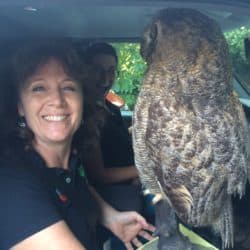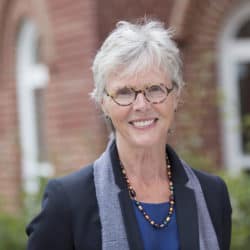As we mark the 150th anniversary of confederation, The Philanthropist is profiling Canadians from across the non-profit sector and putting a face to 150 individuals who work or volunteer in Canada’s social sector.
Name: Lynn Bevan
Current role in the sector: Lawyer. Donor. Volunteer. Advisor. Alternate Discrimination and Harassment Counsel for the Law Society of Upper Canada.
Years working and/or volunteering in the non-profit sector: 40+
What was your first job in the sector or your defining moment?
I worked with what was then called The Association for the Mentally Retarded, now the Association for Community Living, the summer before I went to law school. That experience cemented in me the goal to help vulnerable people, both professionally and as a volunteer. I was able to realize that goal.
Describe your desk/workspace.
I find my workspace in Toronto to be a place of beauty. The desk surface runs in two directions, each over two metres long. One section overlooks a pond, and the other is located beneath hanging shelves that are filled with books that I plan to read next, an Inuit whalebone carving acquired on one of my working trips to the Artic, photos of family and friends, interesting tributes from boards on which I have served, my grandmother’s pocket watch and a flute.
On my desk, I have the sterling silver letter opener given to me on my retirement as Editor of The Philanthropist, a box of vintage postcards that a relative collected, a bottle of green ink for one of my fountain pens and a postcard entitled “Helpful Notes about Interruptions”.
What are you reading or following that has expanded your understanding of the non-profit sector?
I engage with Twitter and Facebook, as well as more traditional sources of information both in print and online – newspapers, periodicals, news television. I have observed how social media and crowdfunding have accelerated the creation of community, empowered community activism and revealed the deep differences that exist among people. A recent example was the Women’s March, which I and 60,000 others joined in Toronto, all organized in a very short time.
One issue that I follow closely is Canada’s recognition of its Indigenous peoples and acknowledgement of prior wrongs. I have long believed that Canada’s shame has been the way it has treated its Indigenous people. For example, as I write, there are over 130 communities without safe drinking water, with some communities having had to boil water for up to 20 years. Few other Canadians have been asked to carry that burden.
For you as a past author with the journal, please share with us your reflections on what has changed and/or stayed the same since writing the following article:
In “From the Editor”, Issue 4, Vol. 4, published in October 1984, I wrote “This issue considers the necessity for ‘making the best use of diminishing resources.’ We expect it to be a recurring theme. Reduced government funding and declining public support have caused voluntary organizations to seek new ways to maximize the effectiveness of one of their most important resources – volunteers.”
Has much changed in the last 32 years? No, and yes. What hasn’t changed is that volunteers are still one of the most important resources that not-for-profit organizations have. It is still essential that organizations maximize their volunteers’ talents, skills and desire to contribute, through training and engagement. Many other things have changed, including the diversity of volunteers, the requirements for greater screening of volunteer candidates, and the greater reliance on volunteer labour to compensate for reduced funding for paid staff. In recognition of the importance of volunteers, I continue to commit time and financial resources to organizations who take volunteerism seriously. Often, I have found volunteers are the longest-serving people in the place.
Do you know someone we should profile as part of this series? Email us at philanthropistprofiles@gmail.com


